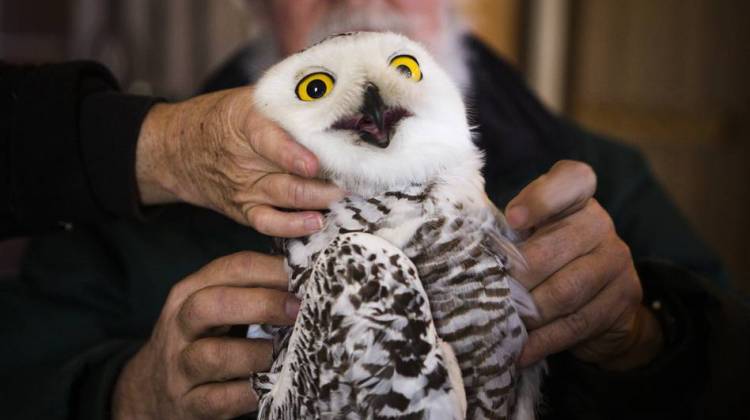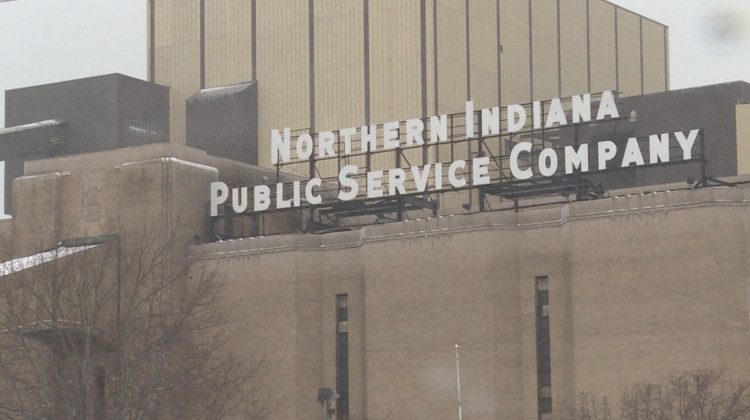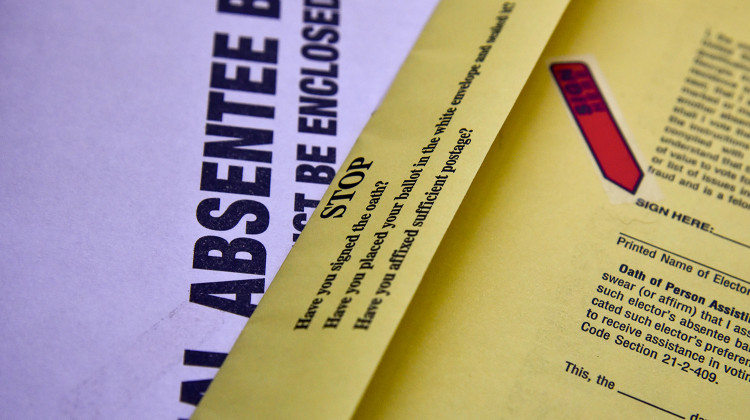This is Hungerford, a large female snowy owl. Last summer she was just a hatchling — a gray ball of fuzz in the middle of the Arctic tundra. In the fall, newly equipped with adult plumage, she flew thousands of miles south until she reached the coast of Maryland. And this winter, she became an important part of an unprecedented research project.
'Something Huge Is Going On'
Snowy owls are among the largest birds in North America, but scientists know very little about their behavior. The owls spend most of their days far from humans, hunting rodents and birds in the flat expanses of the Arctic Circle. In the winter, the owls move south, but they don't usually reach the United States. Most years, only a few are spotted in the northernmost states — a rare treat for birders. But this winter was different.
Owls started to appear all over the United States right around Thanksgiving — in Nebraska, in Kentucky — even as far south as Georgia. Dave Brinker, a biologist with the Maryland Department of Natural Resources, was shocked when he saw not one but two snowy owls on a small stretch of Maryland beach.
"Something huge is going on," Brinker told his colleagues. "We won't see something like this for a long time — probably for the rest of our lifetimes."
This rapid population boom — called an "irruption" by ecologists — is the largest the East Coast has seen in 40 or 50 years.
The Trigger (Lemmings!)
So what caused the irruption? This picture tells the story:
It shows a snowy owl's nest that was photographed by biologists last summer in northern Quebec. Those furry lumps are the carcasses of 70 lemmings. Lemmings — small, hamsterlike rodents — are the main source of food for snowy owls in the Arctic. Thanks to the abundance of lemmings last summer, well-fed mother owls laid more eggs, and huge numbers of owlets grew up fat and strong. Come winter, they spread far to the south.
This irruption has provided a once-in-a-lifetime opportunity for owl researchers — the chance to tag and track members of a mysterious species. Brinker says that following the movements of a few snowy owls will give scientists unprecedented information — about their routes through Canada and around the Arctic Circle, about their hunting patterns, and about the human-made hazards they face. That new understanding, in turn, will help the scientists better protect the owls.
So Brinker teamed up with his colleague Scott Weidensaul to launch Project Snowstorm. They quickly cobbled together a nationwide team of owl fanatics and raised $36,000 dollars through a crowdfunding website to buy about two-dozen custom-built GPS transmitters.
The Trap
But they still had to catch the owls. The researchers began by visiting places where snowy owls had been regularly spotted — often flat, open areas like beaches and airports that look a bit like arctic tundra. Once they spotted an owl, they set up a trap nearby, and then ... they waited.
Weidensaul and Brinker both use a trap called a bow net. It looks a bit like a hockey goal — a large rectangular frame that supports a loose netting. The bait is a pigeon. It's outfitted with a sturdy leather jacket to protect it from piercing talons. When an owl swoops in to snatch the pigeon, the net arcs up over it, harmlessly pinning it to the ground.
Project Snowstorm volunteer Steve Huy captured Hungerford on Assateague, an island off Maryland's coast. Huy is an analyst for Marriott International, but he has special training — and a permit — to trap and handle owls.
Huy and Brinker worked together to measure Hungerford's wingspan, tail length and fat stores. They carefully placed a metal band around her leg so she can be identified if she is ever recaptured. They took feather and blood samples that will help them learn more about Hungerford's diet, genetics and exposure to man-made toxins.
Hungerford was still and calm through most of the process, staring around the small cabin that serves as Assateague's research headquarters. But every once in a while, she let out a high-pitched twitter of disapproval and nipped at Huy's hands with her sharp beak.
The Transmitter
Finally, Brinker and Huy fitted Hungerford with a GPS transmitter. It's solar-powered and weighs just 40 grams, less than 3 percent of Hungerford's weight. She wears it like a backpack, with two custom-sewn Teflon straps wrapped snugly around her shoulders so they don't interfere with flight.
"At first they're going to notice it," Brinker says, "but they get used to it pretty quick."
Before releasing Hungerford back into the wild, Huy tried to give her some extra fuel in the form of a dead mouse. Maybe it was the stress of capture or maybe it was too early in the day for her to eat, but she wasn't interested.
Huy released Hungerford on the beach where she was captured, and she glided out into the dunes.
Already, her GPS unit was collecting data: longitude, latitude and altitude, every half-hour. And from Minnesota to Rhode Island, the transmitters of the 15 other owls tagged so far do the same. Every three days, they connect to a cellphone network and send all of their data back to Project Snowstorm.
"We're all sitting there, 7 o'clock, every third day. It's like ... who's checking in?" Brinker says. "They're what's providing our daily excitement now."
Hungerford's first few data points show her spending the rest of the day among Assateague's dunes, but after sunset she flew north. Soon, snowy owls all across the United States will join her, starting the long journey back to their arctic breeding grounds. And a few of them, like Hungerford, will carry a high-tech accessory.
You can follow the journeys of all of the tagged owls on the Project Snowstorm website.
 DONATE
DONATE










 View More Programs
View More Programs

 Support WFYI. We can't do it without you.
Support WFYI. We can't do it without you.